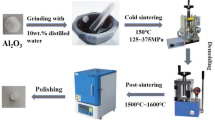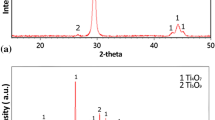Abstract
Ce x Zr1−x O2 (x = 0.10, 0.16 and 0.33) nanocrystalline powders were obtained by a two-step synthesis technique and sintered by spark plasma sintering (SPS). As consequence of the reduction of Ce4+ to Ce3+ species by carbon in the graphite environment in SPS, phase assemblies including tetragonal, monoclinic and pyrochlore phases were generated in the ceramics during the sintering process. The electrical conductivity was highly dependent on phase assembly and atmosphere (N2, H2 and O2). A significant decrease in the activation energy was noticed in the ceramics with high pyrochlore content when measuring the conductivity in H2 atmosphere, consequence of the strong reduction promoted in these ceramics during the measurement. Equal conduction behavior with similar activation energy was observed in all the ceramics when measuring in O2 atmosphere.








Similar content being viewed by others
References
Kaspar J, Fornasiero P, Graziani M (1999) Use of CeO2-based oxides in the three-way catalysis. Catal Today 50(2):285–298
Trovarelli A (2002) Catalysis by ceria and related materials. Imperial College press, London
Fergus JW (2006) Oxide anode materials for solid oxide fuel cells. Solid State Ion 177(17–18):1529–1541
Boaro M, Vicario M, Llorca J, de Leitenburg C, Dolcetti G, Trovarelli A (2009) A comparative study of water gas shift reaction over gold and platinum supported on ZrO2 and CeO2–ZrO2. Appl Catal B Environ 88(3–4):272–282
Reidy RF, Simkovich G (1993) Electrical conductivity and point defect behavior in ceria-stabilized zirconia. Solid State Ion 62(1–2):85–97
Chiodelli G, Flor G, Scagliotti M (1996) Electrical properties of the ZrO2–CeO2 system. Solid State Ion 91(1–2):109–121
Boaro M, Trovarelli A, Hwang JH, Mason TO (2002) Electrical and oxygen storage/release properties of nanocrystalline ceria–zirconia solid solutions. Solid State Ion 147(1–2):85–95
Lee JH, Yoon SM, Kim BK, Lee HW, Song HS (2002) Electrical conductivity and defect structure of CeO2–ZrO2 mixed oxide. J Mater Sci 37(6):1165–1171
Lee JH, Yoon SM, Kim BK, Kim J, Lee HW, Song HS (2001) Electrical conductivity and defect structure of yttria-doped ceria-stabilized zirconia. Solid State Ion 144(1–2):175–184
Shannon RD (1976) Revised effective ionic radii and systematic studies of interatomic distances in halides and chalcogenides. Acta Cryst A 32:751–767
Otake T, Yugami H, Naito H, Kawamura K, Kawada T, Mizusaki J (2000) Ce3+ concentration in ZrO2–CeO2–Y2O3 system studied by electronic Raman scattering. Solid State Ion 135(1–4):663–667
Huang S, Li L, Van der Biest O, Vleugels J (2005) Influence of the oxygen partial pressure on the reduction of CeO2 and CeO2–ZrO2 ceramics. Solid State Sci 7(5):539–544
Belous AG, Kravchyk KV, Pashkova EV, Bohnke O, Galven C (2007) Influence of the chemical composition on structural properties and electrical conductivity of Y–Ce–ZrO2. Chem Mater 19(21):5179–5184
Baidya T, Hegde MS, Gopalakrishnan J (2007) Oxygen-release/storage properties of Ce0.5M0.5O2 (M=Zr, Hf) oxides: interplay of crystal chemistry and electronic structure. J Phys Chem B 111(19):5149–5154
Song SD, Fuentes RO, Baker RT (2010) Nanoparticulate ceria–zirconia anode materials for intermediate temperature solid oxide fuel cells using hydrocarbon fuels. J Mater Chem 20(43):9760–9769
Boaro M, Desinan S, Abate C, Ferluga M, de Leitenburg C, Trovarelli A (2001) Study on redox, structural and electrical properties of Ce x Zr1−x O2 for applications in SOFC anodes. J Electrochem Soc 158(2):22–29
Cruz SA, Poyato R, Cumbrera FL, Odriozola JA (2012) Nanostructured spark plasma sintered Ce-TZP ceramics. J Am Ceram Soc 95(3):901–906
Omori M (2000) Sintering, consolidation, reaction and crystal growth by the spark plasma system (SPS). Mat Sci Eng A 287:183–188
Munir ZA, Anselmi-Tamburini U, Ohyanagi M (2006) The effect of electric field and pressure on the synthesis and consolidation of materials: a review of the spark plasma sintering method. J Mater Sci 41(3):763–777
Anselmi-Tamburini U, Garay JE, Munir ZA (2006) Fast low-temperature consolidation of bulk nanometric ceramic materials. Scr Mater 54(5):823–828
Omata T, Kishimoto H, Otsuka-Yao-Matsuo S, Ohtori N, Umesaki N (1999) Vibrational spectroscopic and X-ray diffraction studies of cerium zirconium oxides with Ce/Zr composition ratio = 1 prepared by reduction and successive oxidation of t′-(Ce0.5Zr0.5)O2 phase. J Solid State Chem 147(2):573–583
Hui Z, Nicolas G, Francoise V, Michele P (2003) Preparation and electrical properties of a pyrochlore-related Ce2Zr2O8−x phase. Solid State Ion 160(3–4):317–326
Ouyang J, Yang HM (2009) Investigation of the oxygen exchange property and oxygen storage capacity of Ce x Zr1−x O2 nanocrystals. J Phys Chem C 113(17):6921–6928
Leonov AI, Andreeva AB, Keler EK (1966) Influence of the gas atmosphere on the reaction of zirconium dioxide with oxides of cerium. Izq Akad Nauk SSSR Neorganicheskie Mater 2:137–144
Rodriguez-Carvajal J (1990) FULLPROF: a program for Rietveld refinement and pattern matching analysis. In: Abstracts of the satellite meeting on powder diffraction of the XV congress of the IUCr, pp 127–130
Ortiz AL, Sánchez-Bajo F, Padture NP, Cumbrera FL, Guiberteau F (2001) Quantitative polytype-composition analyses of SiC using X-ray diffraction: a critical comparison between the polymorphic and the Rietveld methods. J Eur Ceram Soc 21:1237–1248
Caglioti G, Paoletti A, Ricci FP (1958) Choice of collimators for a crystal spectrometer for neutron diffraction. Nucl Inst 3:223–228
Pecharsky VK, Zavalij PY (2009) Fundamentals of powder diffraction and structural characterization of materials, 2nd edn. Springer, Berlin
Kaspar J, Formagiero P (2002) Structural properties and thermal stability of ceria-zirconia and related materials. In: Trovarelli A (ed) Catalysis by ceria and related materials. Imperial College press, London, pp 217–241
Huang SG, Van der Biest O, Vleugels J, Vanmeensel K, Li L (2007) Characterization of Y2O3, CeO2 and Y2O2 + CeO2FGM tetragonal ZrO2 ceramics by spark plasma sintering. Key Eng Mater 333:231–234
Thomson JB, Armstrong AR, Bruce PG (1999) An oxygen-rich pyrochlore with fluorite composition. J Solid State Chem 148:56–62
Sasaki T, Ukyo Y, Kuroda K, Arai S, Muto S, Saka H (2004) Crystal structure of Ce2Zr2O7 and β-Ce2Zr2O7.5. J Ceram Soc Jpn 112:440–444
Kishimoto H, Omata T, Otsuka-Yao-Matsuo S, Ueda K, Hosono H, Kawazoe H (2000) Crystal structure of metastable κ-CeZrO4 phase possessing an ordered arrangement of Ce and Zr ions. J Alloys Compd 312:94–103
Thornber MR, Bevan DJM, Graham J (1968) Mixed oxides of the type MO2(fluorite)–M2O3. III. Crystal structures of the intermediate phases Zr5Sc2O13 and Zr3Sc4O12. Act Cryst B 24:1183–1190
Wuensch BJ, Eberman KW (2000) Order-disorder phenomena in A2B2O7 pyrochlore oxides. J Metals 52:19–21
Werner PE, Erikson L, Westdahl M (1985) TREOR, a semi-exhaustive trial-and-error powder indexing program for all symmetries. J Appl Cryst 18:367–370
de Wolff PM (1968) A simplified criterion for the reliability of a powder pattern indexing. J Appl Cryst 1:108–113
Acknowledgements
Dr. Cruz thanks Junta de Andalucía (TEP-1048) for her fellowship. The financial support for this work has been obtained from the Spanish Ministerio de Ciencia e Innovación (ENE2009-14522-C05-01) and (ENE2009-14522-C05-03). Cofinanced by FEDER funds from the European Union and from Junta de Andalucía (P09-TEP-5454).
Author information
Authors and Affiliations
Corresponding author
Rights and permissions
About this article
Cite this article
Poyato, R., Cruz, S.A., Cumbrera, F.L. et al. Phase assembly and electrical conductivity of spark plasma sintered CeO2–ZrO2 ceramics. J Mater Sci 49, 6353–6362 (2014). https://doi.org/10.1007/s10853-014-8361-6
Received:
Accepted:
Published:
Issue Date:
DOI: https://doi.org/10.1007/s10853-014-8361-6




